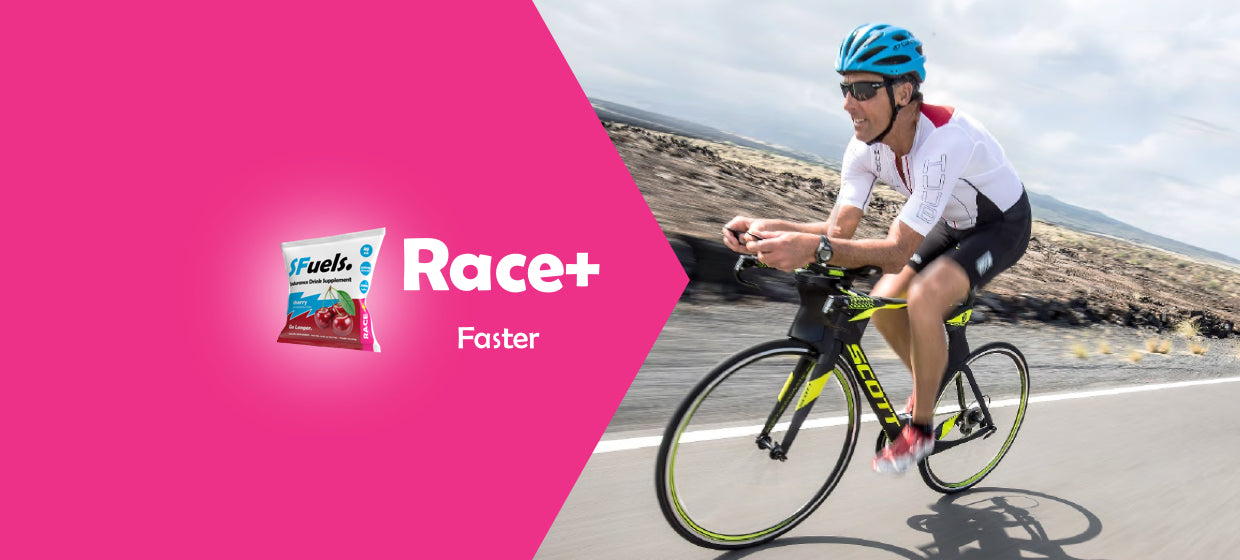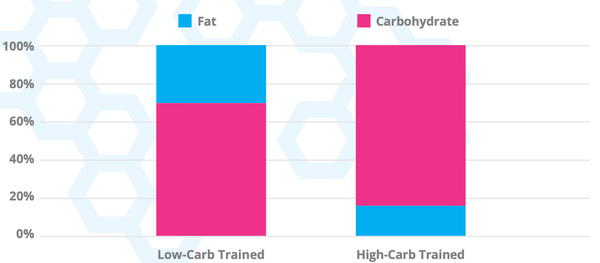
SFuels Race+ Product Overview
Racing and high intensity
VO2 Max subtrate testing has shown that Low-Carb trained athletes can oxidize fats at over 90 grams per hour, 3-4 times more than high-carb trained athletes.
This supports the low-carb trained athlete to train or race at higher intensities, while consuming fewer carbs, avoiding the infamous bonk, hitting-the-wall, race stopping gut-distress and unmanageable energy swings.
Fat/Carb % Oxidation Efficiency at High Intensity (Comparison at 270W Cycling)

Train and test your fuel-water dosage requirements against race day expected intensities, temperature, elevation and duration.
Guidance: Product Choice depending on Intensity (rate of perceived exertion) and Duration:

Pre-Race Morning and Race Start
It’s important not to consume insulin triggering grains, simple sugars and dairy on race morning. Also, complete the first 30-60 minutes of your race without any intake of sugars/carbs.
Applying this to your race-day prep enables muscle cell glucose transporters, to rapidly move to the cell wall, open glucose channels and allow the free flow of glucose into the muscle cells, without insulin.
Muscle cells can then simultaneously oxidize both fats and glucose to provide a smooth supply of energy and power throughout your race. By enabling high fat oxidation during high intensity racing, athletes will need less carbohydrate to perform and also mitigate the risk of race-stopping gut distress from simple sugars like sucrose (fructose+glucose) and fructose.
Dosage Guidance – During Race
During high-intensity racing and training, low-carb trained athletes can be burning over 800 calories of fat per hour, plus additionally burning carbohydrates. With the majority of energy coming from fat oxidation, the amount of carbohydrate needed to be consumed is far less.

As intensity levels shift during the race (from changes in elevation, wind, heat/humidity, competitive-racing dynamics and exhaustion) the amount of calories burned will change – and so too does the required amount of carbohydrate intake change. See P17 of the SFuels QuickStart Guide to see more details of the dosing.
Testing fuel-dosages at various intensities in training is critical to best optimise race performance outcomes and mitigate under/over hydration and gut-distress issues.
Race+ Storage Ideas

Summary:
Fuel high-intensity training and racing by simultaneously burning fats and carbs. Using pre-digested branch chained starches with MCT oils, while avoiding any use of simple sugars, sugar alcohols and spiking maltodextrins.
Enable rapid transit of calories through upper GI track while racing, by only using carbs with low osmolality and pre-digested branch chain starches and medium-chain triglycerides, while avoiding gut irritants like fructose and sugar alcohols.
Maintain dependable neuromuscular communications and support most efficient gut absorption by supplementing with sodium, calcium, potassium and gut-friendly magnesium.
Minimise exercise induced GI/gut distress and delayed onset muscle soreness by fueling - feeding the muscles and the gut membrane with clinical levels of glutamine.




Leave a comment